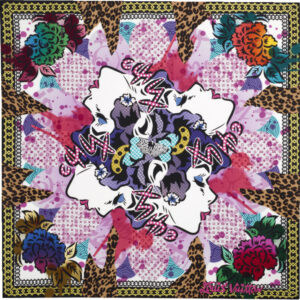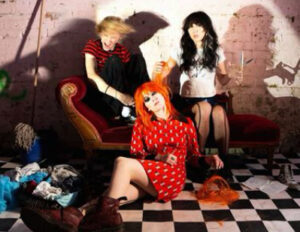

In the ever-evolving conversation between high fashion and contemporary art, few brands have mastered the dialogue as masterfully as Louis Vuitton. From its historic collaborations with Takashi Murakami and Yayoi Kusama to more recent partnerships with Supreme and artist Urs Fischer, Louis Vuitton has consistently shown a deft ability to blur the lines between wearable luxury and museum-worthy art. Now, the French luxury house reaffirms this creative legacy through its new capsule: ‘Foulards d’Artistes’, featuring convergences with Olivier Zahm and Lady Aiko.
At first glance, scarves might seem like a subtle canvas — delicate squares of silk, ephemeral and soft. But under Vuitton’s masterstroke, these scarves become powerful statements: personal galleries wrapped around the neck, fluttering symbols of individual identity and collective cultural commentary.
A Legacy of Artistic Collaboration
Louis Vuitton’s embrace of the arts isn’t merely a marketing strategy; it’s a philosophical stance rooted in the brand’s DNA. Beginning with Stephen Sprouse’s graffiti-inspired collection in 2001, under the stewardship of then-creative director Marc Jacobs, Vuitton set a precedent that the monogram canvas could be more than a logo — it could be a canvas.
This vision has only deepened in the decades since. Each new collaboration becomes a chapter in a living archive that chronicles the shifting tides of visual culture, blending the maison’s heritage craftsmanship with avant-garde expression. The Foulards d’Artistes collection stands as a testament to this ongoing narrative.
The Silk Scarf: A Canvas of Resistance and Elegance
Historically, the scarf has transcended mere function to become a potent symbol. From Hermès’ horse-inspired squares in the 1930s to punk rock’s studded bandanas in the 1970s, scarves have embodied everything from aristocratic grace to subcultural rebellion.
In the luxury context, silk scarves offer a paradox: they are delicate yet bold, classic yet infinitely versatile. They invite intimacy — they rest on skin, they move with the body — yet they are publicly expressive, catching eyes and starting conversations. For Louis Vuitton, the scarf becomes the perfect site to explore the tensions between art and fashion, form and message.
Olivier Zahm: The Chronicler of Subversive Chic
Olivier Zahm, the founder of Purple magazine, is no stranger to the world of provocative aesthetics. Since the 1990s, Zahm has positioned himself as a sort of contemporary flâneur, documenting underground fashion scenes, erotic subcultures, and avant-garde art through his raw, voyeuristic lens.
His contribution to the Foulards d’Artistes collection brings this rebellious sensibility into silk. Zahm’s design is a collage-like print, evoking the torn pages of independent zines and underground posters. Visually chaotic yet meticulously composed, his scarf features overlaid photography, suggestive phrases, and stark, punk-inspired graphics.
Through this scarf, Zahm invites the wearer into a clandestine world — a wearable manifesto for those who thrive on the edge of the mainstream. It’s not just an accessory; it’s an act of sartorial defiance, challenging the polished conventions of haute fashion with raw authenticity.
Aiko: From Street to Silk
In contrast to Zahm’s grunge-laden aesthetic, Japanese-born, New York-based artist Lady Aiko (Aiko Nakagawa) brings a vibrant, romantic energy to her scarf design. As a pioneering female voice in the male-dominated world of street art, Aiko’s work fuses Eastern femininity with Western graffiti traditions. Her murals and installations often center around themes of love, freedom, and empowered sensuality.
For Foulards d’Artistes, Aiko transforms her signature motifs into a tapestry of swirling colors, blossoming flowers, and playful figures. Her scarf is alive with motion and joy, capturing the spontaneity of her large-scale street pieces but distilled into an intimate, personal accessory.
Wearing Aiko’s scarf is like carrying a piece of an urban mural on your shoulders — a quiet yet powerful assertion of individuality and optimism amidst urban chaos.
Craftsmanship: The Marriage of Tradition and Innovation
Each scarf in the Foulards d’Artistes collection is meticulously crafted in Lyon, France, a city historically renowned for its silk-making heritage. The choice to produce these pieces in Lyon is more than a nod to tradition; it ensures that each artist’s vision is faithfully rendered with the utmost attention to detail.
Printing Aiko’s explosive palette or Zahm’s layered photographic montages onto delicate silk demands both technical mastery and artistic sensitivity. The artisans must balance color saturation, line clarity, and texture to translate street-level dynamism and subcultural grit into something that retains its essence while functioning as wearable luxury.
Cultural Context: Art, Fashion, and the Democratization of Luxury
The Foulards d’Artistes collection lands in a cultural moment where boundaries between high art and street culture continue to dissolve. Social media platforms, particularly Instagram and TikTok, have accelerated the democratization of luxury, turning once-exclusive objects into globally visible symbols.
Scarves, by virtue of their adaptability, perfectly reflect this cultural fluidity. They can be styled traditionally around the neck, tied to a handbag, worn as a headscarf, or even transformed into a top. They move seamlessly between formal settings and streetwear contexts, echoing the cross-genre creativity that defines our era.
By choosing collaborators like Zahm and Aiko, Louis Vuitton consciously engages with this cultural interplay. The collection is not merely about aesthetic pleasure but about sparking dialogue — about what it means to carry art into everyday life, about whose voices get celebrated, and about how personal style can function as cultural commentary.
Recent Trends: Fashion’s Turn Toward Storytelling
Fashion today is no longer solely about craftsmanship or even pure aesthetics; it’s about narrative. Consumers crave stories — about who designed their pieces, what inspired them, and how these objects connect to broader cultural currents.
Louis Vuitton’s move to foreground artists known for their strong visual and narrative identities aligns with this shift. Zahm’s scarf tells a story of nocturnal subcultures and creative rebellion, while Aiko’s radiates warmth, love, and global feminist solidarity. In both cases, the scarf becomes a wearable chapter of a much larger cultural book.
Styling the Scarf: From Gallery to Street
While deeply artistic, the Foulards d’Artistes collection is also grounded in functionality. The scarves invite playful, endless reinterpretation. For a classic Parisian look, one might fold Aiko’s vibrant piece into a delicate necktie paired with a crisp white shirt and tailored trousers. Zahm’s darker, edgier design could be draped dramatically over an oversized black blazer, creating an aura of moody sophistication.
Beyond the traditional, the scarves can be knotted onto denim jackets, wrapped around wrists, or styled as bandeau tops — each approach telling a new story and revealing new facets of the wearer’s personality.
Louis Vuitton’s Artistic DNA: A Long Game
The Foulards d’Artistes project isn’t an isolated experiment but part of a larger strategy that positions Louis Vuitton as a culture institution rather than just a fashion brand. Under Nicolas Ghesquière and artistic collaborations guided by the house’s forward-thinking approach, Vuitton continues to champion the idea that fashion is a living, evolving art form.
This ethos is reflected in their continuous support for the Fondation Louis Vuitton, the brand’s physical manifestation of its commitment to contemporary art. The Fondation hosts exhibitions that blur the lines between traditional visual arts, performance, and design — much like these scarves blur the lines between accessory and artwork.
Collectors’ Appeal: Beyond Fashion
For collectors, the Foulards d’Artistes pieces are more than beautiful additions to a wardrobe — they are future heirlooms. Limited-run artist mixes often appreciate in cultural and monetary value over time, becoming sought-after trophies in the worlds of both fashion and art.
Just as vintage Hermès scarves have become collector’s items, Vuitton’s artist scarves are poised to achieve similar status. The combination of artistic integrity, masterful craftsmanship, and the brand’s cultural clout ensures these pieces will be cherished and studied long after their initial release.
Final Thoughts: Art You Can Wear, Stories You Can Share
The Foulards d’Artistes collection with Olivier Zahm and Aiko represents a bold, poetic extension of Louis Vuitton’s artistic journey. It’s a testament to the brand’s belief that bespoke can — and should — serve as a canvas for ideas, stories, and emotional expression.
In these scarves, we see silk transformed into a battleground of colors, textures, and cultural references. We see art not confined to gallery walls but fluttering down city streets, peeking out from under trench coats, or wrapped protectively around someone on a breezy summer night.
Through these pieces, Louis Vuitton invites us to consider fashion not just as self-decoration, but as self-declaration — a living, breathing act of creative participation in the cultural zeitgeist.
No comments yet.








